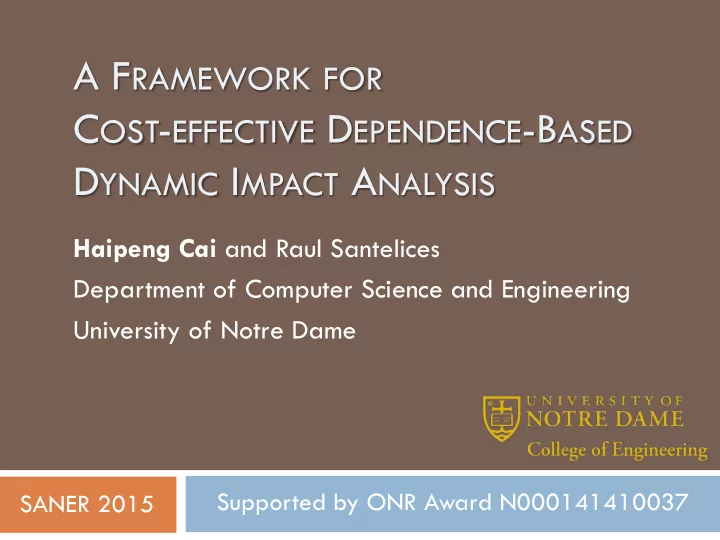

A F RAMEWORK FOR C OST - EFFECTIVE D EPENDENCE -B ASED D YNAMIC I MPACT A NALYSIS Haipeng Cai and Raul Santelices Department of Computer Science and Engineering University of Notre Dame Supported by ONR Award N000141410037 SANER 2015
2 Background Program Execution set (Base version of program) (Set of program inputs) Predictive DDIA Dependence-based Dynamic Impact Analysis Query Impact set (Potential change location) (Set of potential impacts)
3 Problem Efficient approaches are too imprecise (e.g., PathImpact/EAS [T. Apiwattanapong et al., 2005]) Inputs Precise approaches are too expensive (e.g., dynamic slicing [X. Zhang et al., 2004]) Developers need techniques of multiple levels of cost-effectiveness DDIA tradeoffs for diverse needs (e.g., budgets versus the level of precision needed) [C.R. Souza et al., 2008] Impact set
4 Approach Utilize static dependencies in collaboration with method-level Inputs execution traces (i.e., hybrid approach) Exploit additional dynamic information Statement coverage DDIA Dynamic points-to data [M. Mock et al., 2005] Guide trace-based impact computation with both static and dynamic information Impact set
5 Solution A framework that unifies analysis techniques of various cost-effectiveness tradeoffs Including existing representative options (PI/EAS) Spawning three new instances Three new instances TR: static dependencies + method TRaces TC: TR + statement Coverage FI: Full Information -- TC + dynamic points-to data
6 The Framework Static approach TR TC FI PI/EAS
7 Algorithm Dep. graph Dep. graph Method trace TR Report enter return M5 into M2 Prune Dep. graph Stmt. coverage TC Report 2, 12, 13, 25, 145, … Prune Dyn. alias data Dep. graph FI Report P1: O1,O2, O5… P2: 02, O3 …… Prune
8 Experimental setup Subjects 7 Java programs Up to 212 KLOC in size (1k ~ 100k) Techniques PI/EAS (baseline), TR, TC, FI (, FI+) Metrics Effectiveness Impact-set size ratios to baseline Cost Computation time Storage space Average cost-effectiveness Percentage of impact−set reduction factor of time cost increase
9 Research questions How do the techniques compare in terms of effectiveness? How do the techniques compare in terms of costs? What are the effects of different forms of dynamic data on the DDIA cost-effectiveness?
10 Result: effectiveness Effectiveness (Impact-set size ratio)
11 Result: effectiveness Effectiveness (Impact-set size ratio)
12 Research questions How do the techniques compare in terms of effectiveness? How do the techniques compare in terms of costs? What are the effects of different forms of dynamic data on the DDIA cost-effectiveness?
13 Result: querying cost PI/EAS Query time of our techniques (seconds) (seconds Subject ) TR TC FI FI+ 0.70 14.60 15.72 19.24 44.26 Schedule1 0.07 6.24 6.35 5.60 7.97 NanoXML 0.04 7.43 8.01 8.15 16.89 XML-security 0.02 2.25 2.30 1.82 2.18 JMeter 0.05 3.19 3.39 3.31 5.24 Ant-v0 0.29 78.34 99.68 82.55 105.18 Jaba 0.05 15.95 15.98 12.60 15.82 ArgoUML 0.11 26.33 31.96 26.62 35.04 Overall
14 Result: other costs Static-analysis costs in seconds Subject PI/EAS TR TC FI/FI+ Schedule1 5 6 11 17 NanoXML 11 14 25 39 Ant 27 142 170 311 XML-security 33 158 190 280 JMeter 38 372 408 764 Jaba 55 289 326 600 ArgoUML 172 7,465 7,542 11,998 2,115 3,392 73 2,047 Overall Runtime costs: < 1m Space costs: < 4MB
15 Research questions How do the techniques compare in terms of effectiveness? How do the techniques compare in terms of costs? What are the effects of different forms of dynamic data on the DDIA cost-effectiveness?
16 Result: cost-effectiveness With respect to querying costs 9% Schedule1 NanoXML Ant XML-security effectiveness gain/cost increase JMeter Jaba ArgoUML 8% 7% 6% 5% 4% 3% 2% 1% 0% TR TC FI FI+
17 Result: cost-effectiveness With respect to other costs 180% Schedule1 NanoXML Ant XML-security Effectiveness gain/cost increase JMeter Jaba ArgoUML 160% 140% 120% 100% 80% 60% 40% 20% 0% TR TC FI FI+
18 Conclusions A framework that unifies existing and new DDIA techniques, and offers multiple-level cost-effectiveness options New techniques greatly reducing impact-set sizes, implying large improvement in precision Statement coverage has generally stronger effects on DDIA cost-effectiveness than dynamic points-to data
Acknowledgements 19 Office of Naval Research for funding All of you for time and attention
Q&A 20 The proposed framework offers multiple-level trade-offs between cost and effectiveness of dynamic impact analysis. Haipeng Cai http://cse.nd.edu/~hcai/ hcai@nd.edu
Subject programs 21 Subject KLOC #Methods #Tests Schedule1 0.3 24 2,650 NanoXml 3.5 282 214 Ant-v0 18.8 1,863 112 XML-security-v1 22.4 1,928 92 JMeter-v2 35.5 3,054 79 Jaba 37.9 3,332 70 ArgoUML-r3121 102.4 8,856 211
Controversial/provocative statement 22 Achieving 100% recall with respect to actual impacts for dynamic dependence analysis is impossible. Impact analysis is being emphasized all the time but practitioners mostly still stick to old- fashioned ways relying on manual efforts, what are possible obstacles there?
Design space of cost-effective DDIA 23 dynamic slicing This work cost DIVER trace based precision Key idea: Incrementally prune methods NOT dependent on the query
Recommend
More recommend